2020 DODGE GRAND CARAVAN lock
[x] Cancel search: lockPage 52 of 380

50GETTING TO KNOW YOUR VEHICLE
Blower Control
There are seven blower speeds. Use this control to regulate the amount of air forced through the system in any mode you
select. The blower speed increases as you move the control clockwise from the off position.
NOTE:
Depending on the configuration, your vehicle may be equipped with four blower speeds.
Modes Control Button
Toggle the Modes Control Button to adjust airflow distribution. The airflow distribution mode can be adjusted so air comes
from the instrument panel outlets, floor outlets, defrost outlets and demist outlets. The Mode settings are as follows:
Panel Mode Panel Mode
Toggle the Modes Control Button until you see Panel Mode Icon on the display. Air comes from the outlets in the instrument
panel. Each of these outlets can be individually adjusted to direct the flow of air. The air vanes of the center outlets and
outboard outlets can be moved up and down or side to side to regulate airflow direction.
Bi-Level Mode Bi-Level Mode
Toggle the Modes Control Button until you see Bi-Level Mode Icon on the display. Air comes from the instrument panel
outlets and floor outlets. A slight amount of air is directed through the defrost and side window demister outlets.
NOTE:
Bi-Level mode is designed under comfort conditions to provide cooler air out of the panel outlets and warmer air from the
floor outlets.
Floor Mode Floor Mode
Toggle the Modes Control Button until you see Floor Mode Icon on the display. Air comes from the floor outlets. A slight
amount of air is directed through the defrost and side window demister outlets.
Icon Description
20_RT_OM_EN_USC_t.book Page 50
Page 54 of 380

52GETTING TO KNOW YOUR VEHICLE
Icon Description
Rear Lock Button
Press to lock out the rear manual temperature controls from adjusting the rear temperature and blower settings.
Rear Passenger Temperature Up and Down Buttons
Provides the rear passengers with independent temperature control. Push the up arrow button to increase the
temperature. Push the down arrow button to decrease the temperature. When the SYNC feature is active, the rear
temperature and the front passenger’s temperature will move up and down with the driver’s temperature.
SYNC Button — If Equipped
Press the SYNC button to toggle the Sync feature on/off. The SYNC indicator is illuminated when this feature is enabled.
SYNC is used to synchronize the front and rear passenger temperature settings with the driver temperature setting.
Changing the front or rear passenger temperature setting while in SYNC will automatically exit this feature.
Rear Blower Control
Turn the Blower Control Knob clockwise or counter clockwise to adjust blower speed. There are seven blower speeds. Use
this control to regulate the amount of air forced through the system in any mode you select in Rear Compartment. The
blower speed increases as you move the control clockwise from the off position.
Panel Mode Rear Panel Mode
Toggle the Modes Control Button until Rear Panel Mode appears on the display. Air comes from the outlets in the headliner.
Each of these outlets can be individually adjusted to direct the flow of air. Moving the air vanes of the outlets to one side
will shut off the airflow.
20_RT_OM_EN_USC_t.book Page 52
Page 57 of 380

GETTING TO KNOW YOUR VEHICLE55
Rear Temperature Control Knob
To change the temperature in the rear of the vehicle, turn the Temperature Control Knob. Turn it to the right to raise the
temperature, or turn it to the left to lower the temperature. The rear temperature settings are displayed in control head.
When rear controls are locked by the front system, the Rear Temperature Lock symbol on the control head is illuminated and
any rear overhead adjustments are ignored.
Push the Rear Temperature Lock button on the front ATC panel. This turns off the Rear Temperature Lock icon in the rear
temperature knob.
Rear Blower Control Knob
The rear blower control can be manually set to off, or any fixed blower speed by rotating the Blower Control Knob in the rear
of the vehicle. This allows the rear seat occupants to control the volume of air circulated in the rear of the vehicle.
Rear AUTO Mode
Rear AUTO is selected by adjusting the rear blower knob counterclockwise to AUTO. The ATC system will automatically achieve
and maintain that comfort level. When the system is set up for your comfort level, it is not necessary to change the settings.
You will experience the greatest efficiency by simply allowing the system to function automatically.
Icon Description
2
20_RT_OM_EN_USC_t.book Page 55
Page 61 of 380
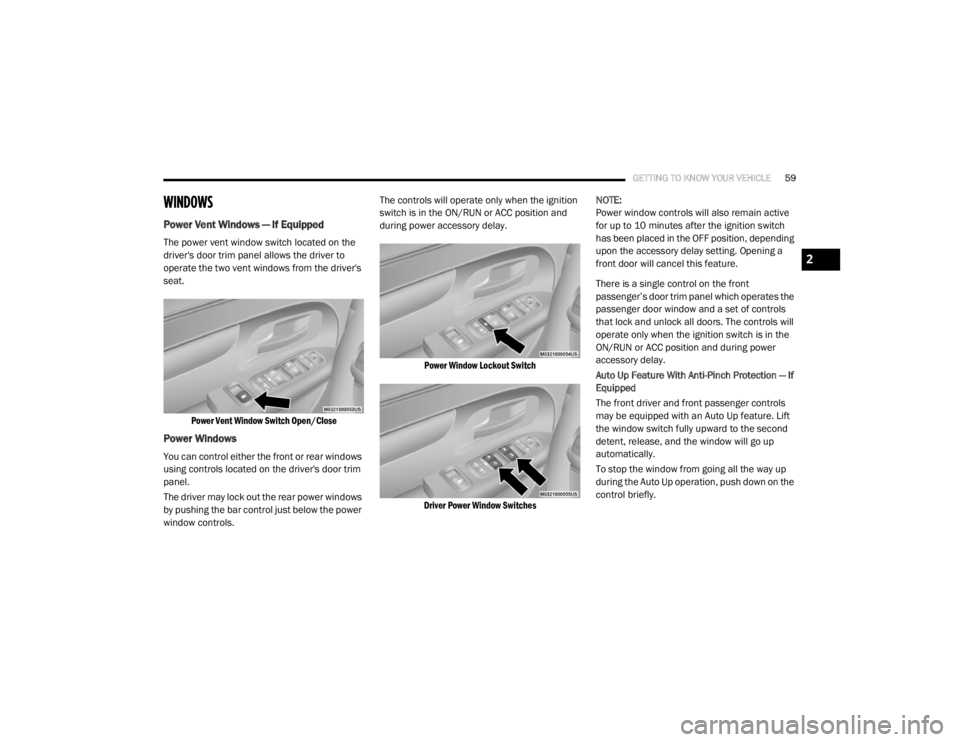
GETTING TO KNOW YOUR VEHICLE59
WINDOWS
Power Vent Windows — If Equipped
The power vent window switch located on the
driver's door trim panel allows the driver to
operate the two vent windows from the driver's
seat.
Power Vent Window Switch Open/Close
Power Windows
You can control either the front or rear windows
using controls located on the driver's door trim
panel.
The driver may lock out the rear power windows
by pushing the bar control just below the power
window controls. The controls will operate only when the ignition
switch is in the ON/RUN or ACC position and
during power accessory delay.
Power Window Lockout Switch
Driver Power Window Switches
NOTE:
Power window controls will also remain active
for up to 10 minutes after the ignition switch
has been placed in the OFF position, depending
upon the accessory delay setting. Opening a
front door will cancel this feature.
There is a single control on the front
passenger’s door trim panel which operates the
passenger door window and a set of controls
that lock and unlock all doors. The controls will
operate only when the ignition switch is in the
ON/RUN or ACC position and during power
accessory delay.
Auto Up Feature With Anti-Pinch Protection — If
Equipped
The front driver and front passenger controls
may be equipped with an Auto Up feature. Lift
the window switch fully upward to the second
detent, release, and the window will go up
automatically.
To stop the window from going all the way up
during the Auto Up operation, push down on the
control briefly.
2
20_RT_OM_EN_USC_t.book Page 59
Page 62 of 380
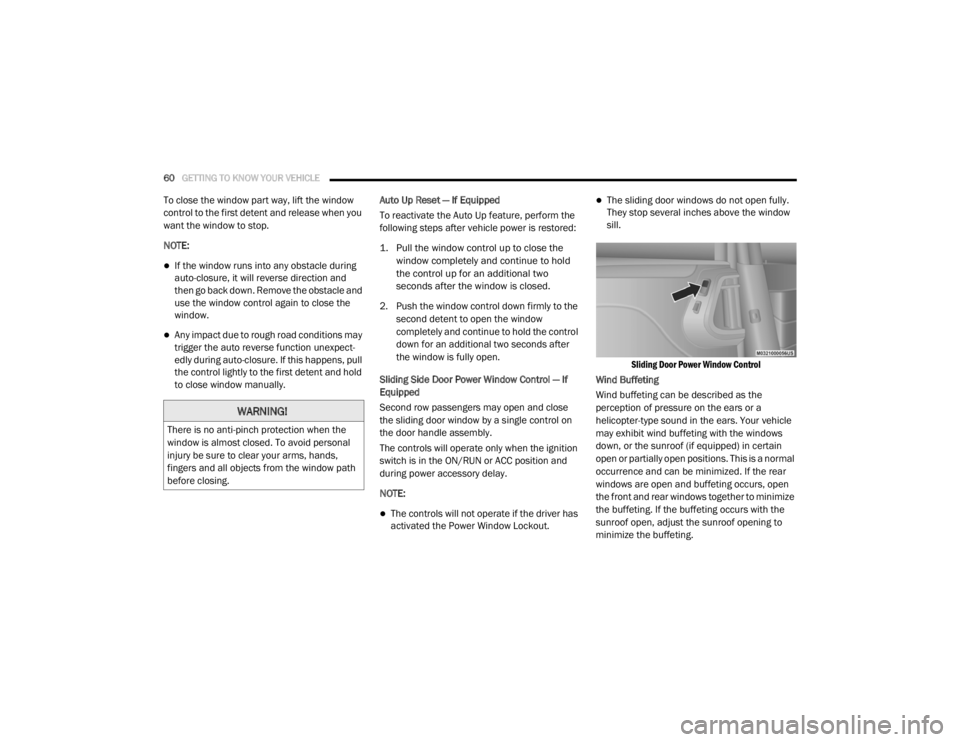
60GETTING TO KNOW YOUR VEHICLE
To close the window part way, lift the window
control to the first detent and release when you
want the window to stop.
NOTE:
If the window runs into any obstacle during
auto-closure, it will reverse direction and
then go back down. Remove the obstacle and
use the window control again to close the
window.
Any impact due to rough road conditions may
trigger the auto reverse function unexpect -
edly during auto-closure. If this happens, pull
the control lightly to the first detent and hold
to close window manually. Auto Up Reset — If Equipped
To reactivate the Auto Up feature, perform the
following steps after vehicle power is restored:
1. Pull the window control up to close the
window completely and continue to hold
the control up for an additional two
seconds after the window is closed.
2. Push the window control down firmly to the second detent to open the window
completely and continue to hold the control
down for an additional two seconds after
the window is fully open.
Sliding Side Door Power Window Control — If
Equipped
Second row passengers may open and close
the sliding door window by a single control on
the door handle assembly.
The controls will operate only when the ignition
switch is in the ON/RUN or ACC position and
during power accessory delay.
NOTE:
The controls will not operate if the driver has
activated the Power Window Lockout.
The sliding door windows do not open fully.
They stop several inches above the window
sill.
Sliding Door Power Window Control
Wind Buffeting
Wind buffeting can be described as the
perception of pressure on the ears or a
helicopter-type sound in the ears. Your vehicle
may exhibit wind buffeting with the windows
down, or the sunroof (if equipped) in certain
open or partially open positions. This is a normal
occurrence and can be minimized. If the rear
windows are open and buffeting occurs, open
the front and rear windows together to minimize
the buffeting. If the buffeting occurs with the
sunroof open, adjust the sunroof opening to
minimize the buffeting.
WARNING!
There is no anti-pinch protection when the
window is almost closed. To avoid personal
injury be sure to clear your arms, hands,
fingers and all objects from the window path
before closing.
20_RT_OM_EN_USC_t.book Page 60
Page 63 of 380
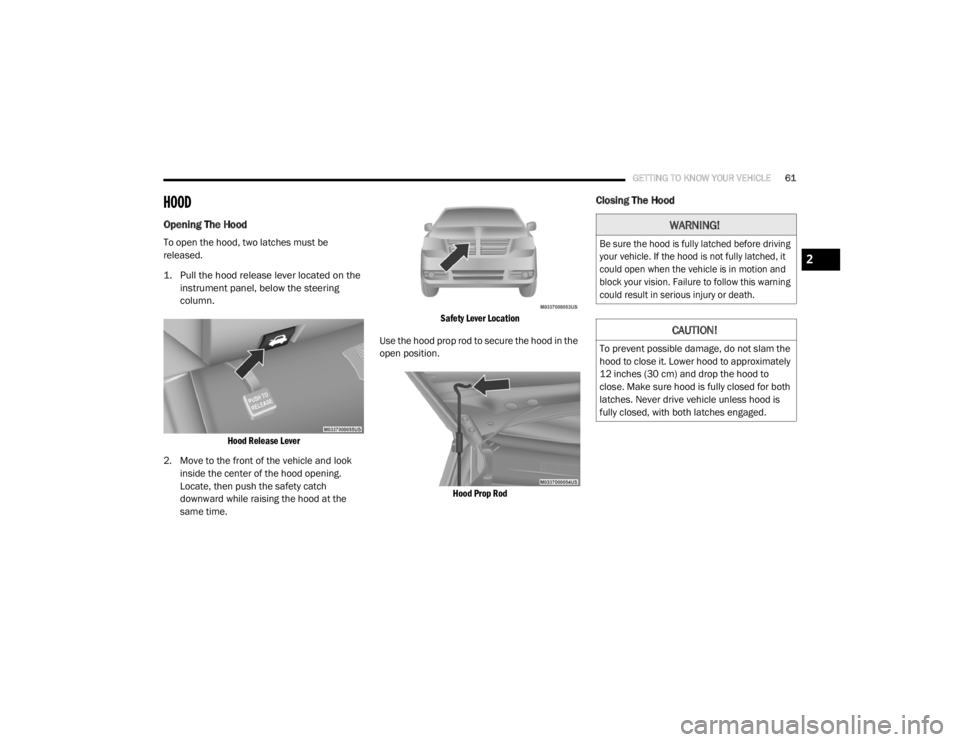
GETTING TO KNOW YOUR VEHICLE61
HOOD
Opening The Hood
To open the hood, two latches must be
released.
1. Pull the hood release lever located on the
instrument panel, below the steering
column.
Hood Release Lever
2. Move to the front of the vehicle and look inside the center of the hood opening.
Locate, then push the safety catch
downward while raising the hood at the
same time.
Safety Lever Location
Use the hood prop rod to secure the hood in the
open position.
Hood Prop Rod
Closing The Hood
WARNING!
Be sure the hood is fully latched before driving
your vehicle. If the hood is not fully latched, it
could open when the vehicle is in motion and
block your vision. Failure to follow this warning
could result in serious injury or death.
CAUTION!
To prevent possible damage, do not slam the
hood to close it. Lower hood to approximately
12 inches (30 cm) and drop the hood to
close. Make sure hood is fully closed for both
latches. Never drive vehicle unless hood is
fully closed, with both latches engaged.
2
20_RT_OM_EN_USC_t.book Page 61
Page 64 of 380
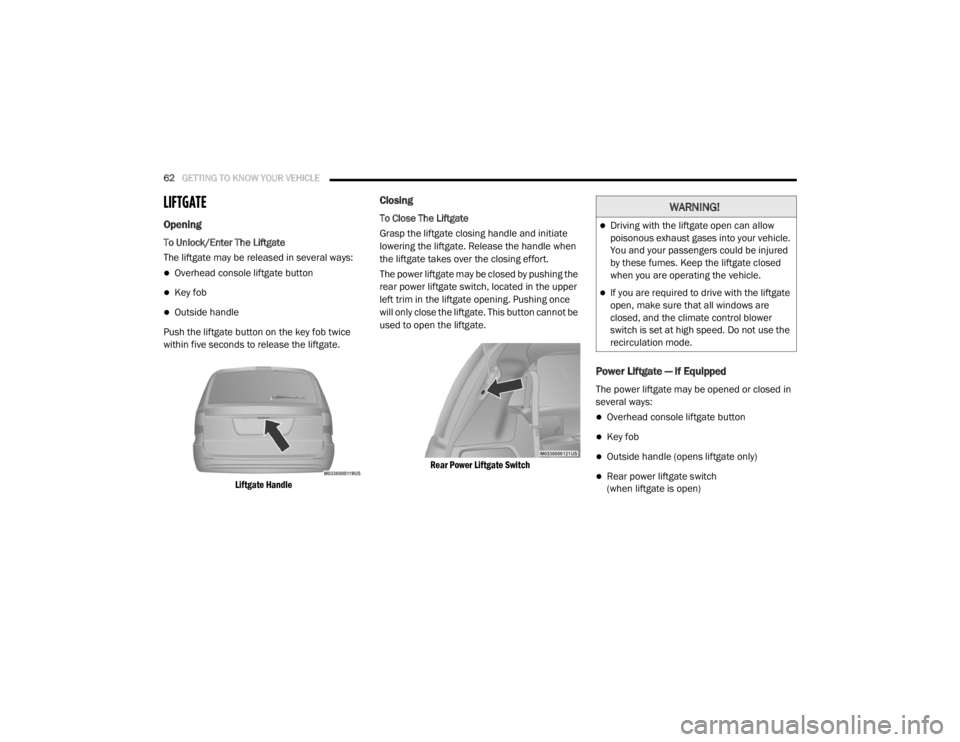
62GETTING TO KNOW YOUR VEHICLE
LIFTGATE
Opening
To Unlock/Enter The Liftgate
The liftgate may be released in several ways:
Overhead console liftgate button
Key fob
Outside handle
Push the liftgate button on the key fob twice
within five seconds to release the liftgate.
Liftgate Handle
Closing
To Close The Liftgate
Grasp the liftgate closing handle and initiate
lowering the liftgate. Release the handle when
the liftgate takes over the closing effort.
The power liftgate may be closed by pushing the
rear power liftgate switch, located in the upper
left trim in the liftgate opening. Pushing once
will only close the liftgate. This button cannot be
used to open the liftgate.
Rear Power Liftgate Switch
Power Liftgate — If Equipped
The power liftgate may be opened or closed in
several ways:
Overhead console liftgate button
Key fob
Outside handle (opens liftgate only)
Rear power liftgate switch
(when liftgate is open)
WARNING!
Driving with the liftgate open can allow
poisonous exhaust gases into your vehicle.
You and your passengers could be injured
by these fumes. Keep the liftgate closed
when you are operating the vehicle.
If you are required to drive with the liftgate
open, make sure that all windows are
closed, and the climate control blower
switch is set at high speed. Do not use the
recirculation mode.
20_RT_OM_EN_USC_t.book Page 62
Page 69 of 380
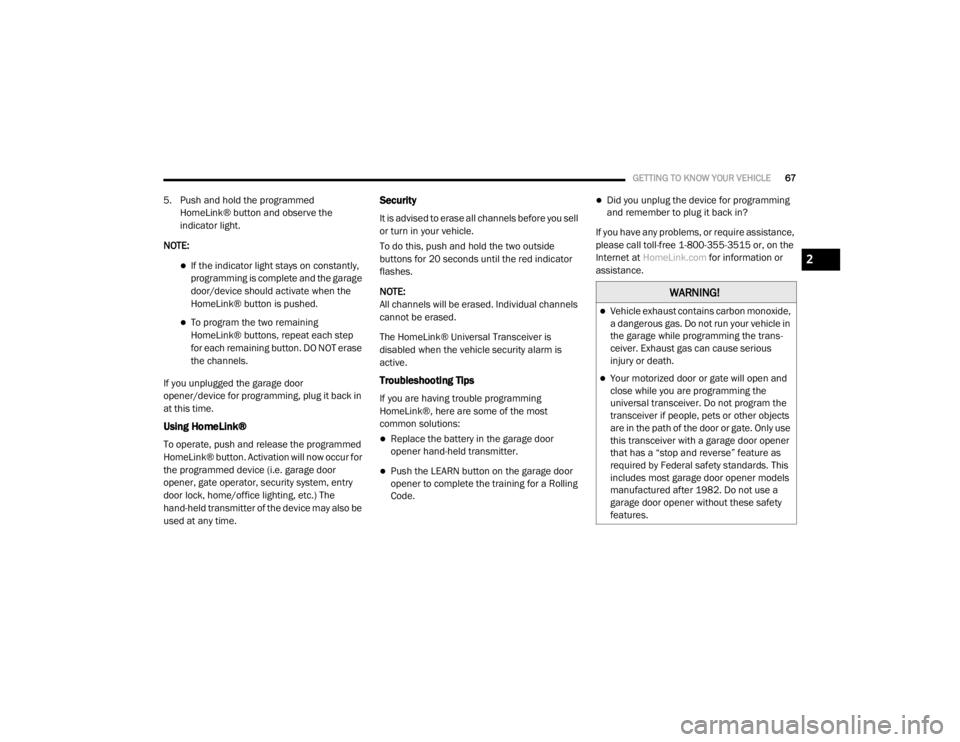
GETTING TO KNOW YOUR VEHICLE67
5. Push and hold the programmed
HomeLink® button and observe the
indicator light.
NOTE:
If the indicator light stays on constantly,
programming is complete and the garage
door/device should activate when the
HomeLink® button is pushed.
To program the two remaining
HomeLink® buttons, repeat each step
for each remaining button. DO NOT erase
the channels.
If you unplugged the garage door
opener/device for programming, plug it back in
at this time.
Using HomeLink®
To operate, push and release the programmed
HomeLink® button. Activation will now occur for
the programmed device (i.e. garage door
opener, gate operator, security system, entry
door lock, home/office lighting, etc.) The
hand-held transmitter of the device may also be
used at any time.
Security
It is advised to erase all channels before you sell
or turn in your vehicle.
To do this, push and hold the two outside
buttons for 20 seconds until the red indicator
flashes.
NOTE:
All channels will be erased. Individual channels
cannot be erased.
The HomeLink® Universal Transceiver is
disabled when the vehicle security alarm is
active.
Troubleshooting Tips
If you are having trouble programming
HomeLink®, here are some of the most
common solutions:
Replace the battery in the garage door
opener hand-held transmitter.
Push the LEARN button on the garage door
opener to complete the training for a Rolling
Code.
Did you unplug the device for programming
and remember to plug it back in?
If you have any problems, or require assistance,
please call toll-free 1-800-355-3515 or, on the
Internet at HomeLink.com for information or
assistance.
WARNING!
Vehicle exhaust contains carbon monoxide,
a dangerous gas. Do not run your vehicle in
the garage while programming the trans -
ceiver. Exhaust gas can cause serious
injury or death.
Your motorized door or gate will open and
close while you are programming the
universal transceiver. Do not program the
transceiver if people, pets or other objects
are in the path of the door or gate. Only use
this transceiver with a garage door opener
that has a “stop and reverse” feature as
required by Federal safety standards. This
includes most garage door opener models
manufactured after 1982. Do not use a
garage door opener without these safety
features.
2
20_RT_OM_EN_USC_t.book Page 67